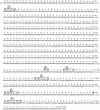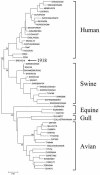Novel origin of the 1918 pandemic influenza virus nucleoprotein gene
- PMID: 15507633
- PMCID: PMC525067
- DOI: 10.1128/JVI.78.22.12462-12470.2004
Novel origin of the 1918 pandemic influenza virus nucleoprotein gene
Abstract
The nucleoprotein (NP) gene of the 1918 pandemic influenza A virus has been amplified and sequenced from archival material. The NP gene is known to be involved in many aspects of viral function and to interact with host proteins, thereby playing a role in host specificity. The 1918 NP amino acid sequence differs at only six amino acids from avian consensus sequences, consistent with reassortment from an avian source shortly before 1918. However, the nucleotide sequence of the 1918 NP gene has more than 170 differences from avian strain consensus sequences, suggesting substantial evolutionary distance from known avian strain sequences. Both the gene and protein sequences of the 1918 NP fall within the mammalian clade upon phylogenetic analysis. The evolutionary distance of the 1918 NP sequences from avian and mammalian strain sequences is examined, using several different parameters. The results suggest that the 1918 strain did not retain the previously circulating human NP. Nor is it likely to have obtained its NP by reassortment with an avian strain similar to those now characterized. The results are consistent with the existence of a currently unknown host for influenza, with an NP similar to current avian strain NPs at the amino acid level but with many synonymous nucleotide differences, suggesting evolutionary isolation from the currently characterized avian influenza virus gene pool.
Figures



Similar articles
-
Evolution of influenza A virus nucleoprotein genes: implications for the origins of H1N1 human and classical swine viruses.J Virol. 1991 Jul;65(7):3704-14. doi: 10.1128/JVI.65.7.3704-3714.1991. J Virol. 1991. PMID: 2041090 Free PMC article.
-
The role of the N-terminal caspase cleavage site in the nucleoprotein of influenza A virus in vitro and in vivo.Arch Virol. 2008;153(3):427-34. doi: 10.1007/s00705-007-0003-8. Epub 2007 Dec 4. Arch Virol. 2008. PMID: 18058063
-
Evolution of pig influenza viruses.Virology. 1991 Jul;183(1):61-73. doi: 10.1016/0042-6822(91)90118-u. Virology. 1991. PMID: 2053297
-
Analysis of influenza A virus nucleoproteins for the assessment of molecular genetic mechanisms leading to new phylogenetic virus lineages.Arch Virol. 1993;131(3-4):237-50. doi: 10.1007/BF01378629. Arch Virol. 1993. PMID: 8347076 Review.
-
Structure and sequence analysis of influenza A virus nucleoprotein.Sci China C Life Sci. 2009 May;52(5):439-49. doi: 10.1007/s11427-009-0064-x. Epub 2009 May 27. Sci China C Life Sci. 2009. PMID: 19471866 Review.
Cited by
-
Microorganisms as Shapers of Human Civilization, from Pandemics to Even Our Genomes: Villains or Friends? A Historical Approach.Microorganisms. 2021 Dec 6;9(12):2518. doi: 10.3390/microorganisms9122518. Microorganisms. 2021. PMID: 34946123 Free PMC article. Review.
-
RNA structural constraints in the evolution of the influenza A virus genome NP segment.RNA Biol. 2014;11(7):942-52. doi: 10.4161/rna.29730. Epub 2014 Jul 23. RNA Biol. 2014. PMID: 25180940 Free PMC article.
-
Synthetic viruses: a new opportunity to understand and prevent viral disease.Nat Biotechnol. 2009 Dec;27(12):1163-72. doi: 10.1038/nbt.1593. Nat Biotechnol. 2009. PMID: 20010599 Free PMC article. Review.
-
Different evolutionary trajectories of European avian-like and classical swine H1N1 influenza A viruses.J Virol. 2009 Jun;83(11):5485-94. doi: 10.1128/JVI.02565-08. Epub 2009 Mar 18. J Virol. 2009. PMID: 19297491 Free PMC article.
-
Spread of influenza virus A (H5N1) clade 2.3.2.1 to Bulgaria in common buzzards.Emerg Infect Dis. 2012 Oct;18(10):1596-602. doi: 10.3201/eid1810.120357. Emerg Infect Dis. 2012. PMID: 23017273 Free PMC article.
References
-
- Basler, C. F., A. H. Reid, J. K. Dybing, T. A. Janczewski, T. G. Fanning, H. Zheng, M. Salvatore, M. L. Perdue, D. E. Swayne, A. Garcia-Sastre, P. Palese, and J. K. Taubenberger. 2001. Sequence of the 1918 pandemic influenza virus nonstructural gene (NS) segment and characterization of recombinant viruses bearing the 1918 NS genes. Proc. Natl. Acad. Sci. USA 98:2746-2751. - PMC - PubMed
-
- Boon, A. C., G. de Mutsert, Y. M. Graus, R. A. Fouchier, K. Sintnicolaas, A. D. Osterhaus, and G. F. Rimmelzwaan. 2002. Sequence variation in a newly identified HLA-B35-restricted epitope in the influenza A virus nucleoprotein associated with escape from cytotoxic T lymphocytes. J. Virol. 76:2567-2572. - PMC - PubMed
-
- Bui, M., J. E. Myers, and G. R. Whittaker. 2002. Nucleo-cytoplasmic localization of influenza virus nucleoprotein depends on cell density and phosphorylation. Virus Res. 84:37-44. - PubMed
-
- Danke, N. A., and W. W. Kwok. 2003. HLA class II-restricted CD4+ T cell responses directed against influenza viral antigens postinfluenza vaccination. J. Immunol. 171:3163-3169. - PubMed
Publication types
MeSH terms
Substances
Associated data
- Actions
LinkOut - more resources
Full Text Sources
Miscellaneous

